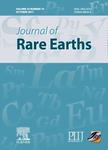Chemical stability of simulated waste forms Zr1–xNdxSiO4–x/2: Influence of temperature, pH and their combined effects
Chemical stability of simulated waste forms Zr_(1–x)Nd_xSiO_(4–x/2): Influence of temperature, pH and their combined effects作者机构:Fundamental Science on Nuclear Wastes and Environmental Safety Laboratory Southwest University of Science and Technology Mianyang 621010 China Key Laboratory of Electronic Information Materials and Devices Chinese Academy of Sciences Urumqi 830011 China Heibei Huicong Ecommerce Company Limited Shijiazhuang 050000 China Institute of Multidisciplinary Research for Advanced Materials Tohoku University Sendai Miyagi 9808577Japan
出 版 物:《Journal of Rare Earths》 (稀土学报(英文版))
年 卷 期:2017年第35卷第7期
页 面:709-715页
核心收录:
学科分类:082704[工学-辐射防护及环境保护] 0709[理学-地质学] 0819[工学-矿业工程] 08[工学] 0708[理学-地球物理学] 0827[工学-核科学与技术] 0703[理学-化学]
基 金:Project supported by the National Natural Science Foundation of China(41302028,41302029,21507105) Thousand Youth Talents Plan(Y42H831301) Key Project of Sichuan Education Department(14ZA0099,15ZB0116) Foundation of Laboratory of National Defense Key Discipline for Nuclear Waste and Environmental Safety,Southwest University of Science and Technology(15yyhk10) the Doctor Foundation in Southwest University of Science and Technology(10zx7126) Hebei Science and Technology Support Program(15211121)
主 题:nuclear waste waste form zircon chemical stability temperature pH rare earths
摘 要:The chemical stability of simulated waste forms Zr_(1–x)Nd_xSiO_(4–x/2) was investigated using the static leach test(MCC-1) with lixiviants of three pH values(pH=4, 6.7 and 10) at three temperature points(40, 90 and 150 oC) for periods ranging from 1 to 42 d, and the influence of temperature, pH, as well as their combined effects were explored in detail. The results showed that all the normalized release rate of Nd firstly decreased with leaching time and closed to equilibrium after 14 d. As the temperature increased, the normalized release rate of Nd also increased, but it was no more than 3×10^(–5) g/(m^2·d). And, the normalized release rate of Nd reached the highest values(~5×10^(–5) g/(m^2·d)) when pH=4, whilst the normalized release rate of Nd remained the lowest value(~1×10^(–5) g/(m^2·d)) near neutral environment(pH=6.7).



